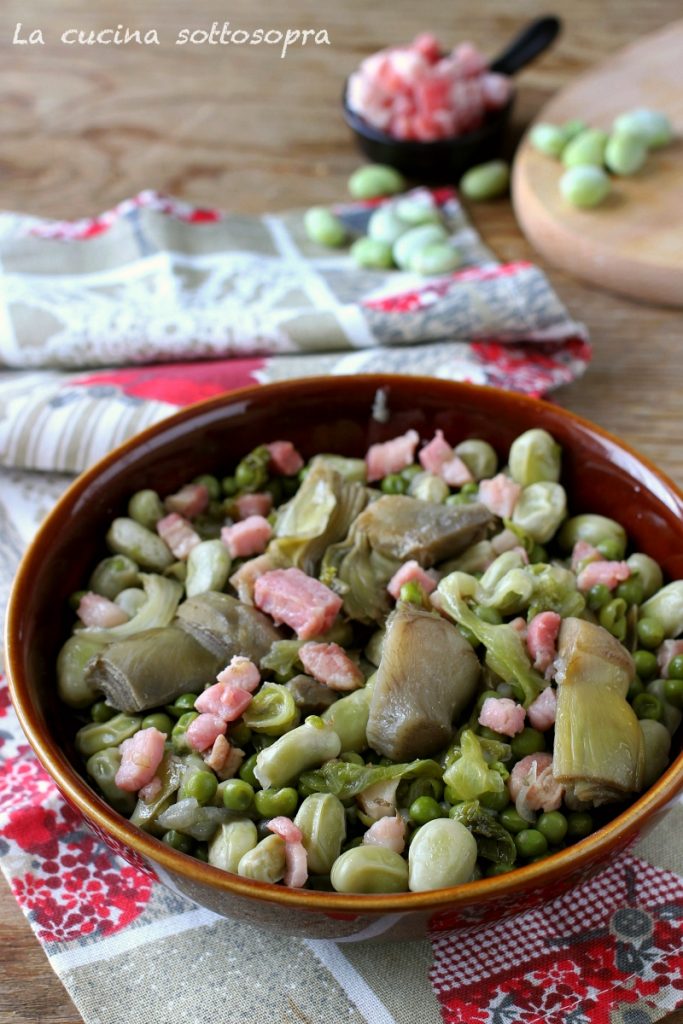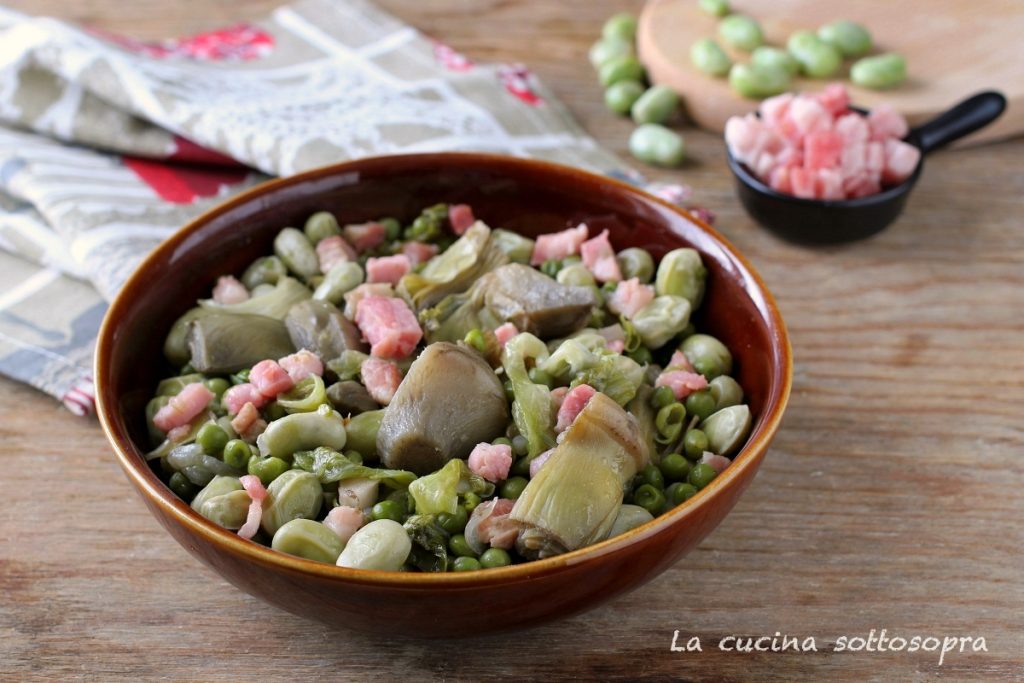The Roman-style vignarola or Roman vignarola is a dish from the Roman peasant tradition. It is a typically spring side dish made with the last artichokes of the season and the first spring produce, which includes fava beans and peas (as well as romaine lettuce).
The origin of the name of this simple yet flavorful dish is disputed: some say it is called so because it was the meal of “vignaroli,” i.e., farmers working in the vineyards. Others claim that the name comes from the fact that the ingredients were sold by “vignaroli,” meaning fruit and vegetable sellers in Roman markets. Whatever the origin related to the name, one thing is certain: this mix of spring flavors and aromas is truly perfect and a must-try.
The Roman-style vignarola originates as a side dish (although it can be considered a rich side dish, given the presence of pork cheek), but it can also be served as an appetizer on crostini, a savory filling for ring-shaped breads and savory pies, and, why not, for delicious pasta dishes.
The preparation, especially if using fresh vegetables, is not the fastest, not so much because of the cooking time, but more because the artichokes need cleaning and the peas and fava beans need to be shelled, but I assure you it is well worth the effort!
The peculiarity of this recipe is that the vegetables must be cooked “step by step”: since they require different cooking times, they shouldn’t be added all at once to the pan, but should be added one at a time, starting with the one that needs the longest cooking time.
Well, now let’s move on to the recipe and see together how to prepare the Roman vignarola.
If you, like me, love dishes with seasonal vegetables, I invite you to take a look at my collection of artichoke recipes and then I’ll leave you with some links for delicious spring side dishes to try during this time!

- Difficulty: Easy
- Cost: Very affordable
- Preparation time: 30 Minutes
- Portions: 4
- Cooking methods: Stovetop
- Cuisine: Regional Italian
- Region: Lazio
- Seasonality: Spring
- Energy 119.49 (Kcal)
- Carbohydrates 9.32 (g) of which sugars 2.61 (g)
- Proteins 4.37 (g)
- Fat 7.49 (g) of which saturated 2.09 (g)of which unsaturated 2.86 (g)
- Fibers 5.06 (g)
- Sodium 82.87 (mg)
Indicative values for a portion of 100 g processed in an automated way starting from the nutritional information available on the CREA* and FoodData Central** databases. It is not food and / or nutritional advice.
* CREATES Food and Nutrition Research Center: https://www.crea.gov.it/alimenti-e-nutrizione https://www.alimentinutrizione.it ** U.S. Department of Agriculture, Agricultural Research Service. FoodData Central, 2019. https://fdc.nal.usda.gov
Ingredients for the Roman-style vignarola
- 14 oz artichokes (net of waste)
- 14 oz fava beans (net of waste)
- 14 oz peas (net of waste)
- 1 head romaine lettuce
- 1 scallions (or 1 white onion)
- 3.5 oz pork cheek
- to taste extra virgin olive oil
- to taste salt
- to taste pepper
- A few leaves wild mint
- to taste water (or vegetable broth)
Tools to prepare Roman-style vignarola
- Skillet
- Knife
- Cutting board
Steps to prepare Roman-style vignarola
Let’s see together how to prepare Roman-style vignarola, this delicious dish from the Roman tradition.
Start by cleaning the artichokes. Put on gloves before starting to avoid staining your hands.
Once done, begin by removing the tougher outer leaves. Once you reach the heart, cut the artichoke in half and remove the “internal fluff” with the tip of a knife. Then cut the artichokes into wedges and place them in a bowl with water and a few drops of lemon.
Shell the fava beans and peas without mixing them. Place them in two separate bowls, as they need to be cooked at different times.
Wash the romaine lettuce and cut it into strips about 1.5 inches wide.
Take a large skillet, add a few tablespoons of extra virgin olive oil, and add the thinly sliced scallion (or onion) with the chopped pork cheek.
Cook over low heat for a few minutes: when the onion becomes almost transparent, begin to add the vegetables, starting with those needing more time to cook.
Add the artichokes to the skillet and a ladleful of vegetable broth or hot water, and cook over moderate heat for 5-10 minutes.
Continue with the fava beans, adding another ladleful of liquid, followed by the peas after about 5 minutes, and then (also after another 5 minutes) the romaine lettuce.
Cook gently with the lid on until all the vegetables are tender and perfectly cooked.
Season at the end of cooking with salt and pepper.
At the end, if you like, you can flavor the vignarola with some fresh mint and serve it with some shavings of Pecorino Romano and a few slices of toasted bread.

Storage, Variations, and Tips
– Roman-style vignarola can be prepared a few hours in advance and served hot or at room temperature.
– If there are leftovers, store them in a tightly sealed container in the refrigerator for up to 2-3 days.
– The original recipe involves using pork cheek, but if you can’t find it, you can substitute with diced bacon (but this will deviate from the original recipe!).
– If you want to try Roman-style vignarola but don’t have the time (or desire) to clean fresh vegetables, you can also use frozen fava beans, peas, and artichoke hearts, following the same order for cooking them (first artichokes, then fava beans, then peas, and finally lettuce). This way it will be much quicker to prepare this delicious side dish!

